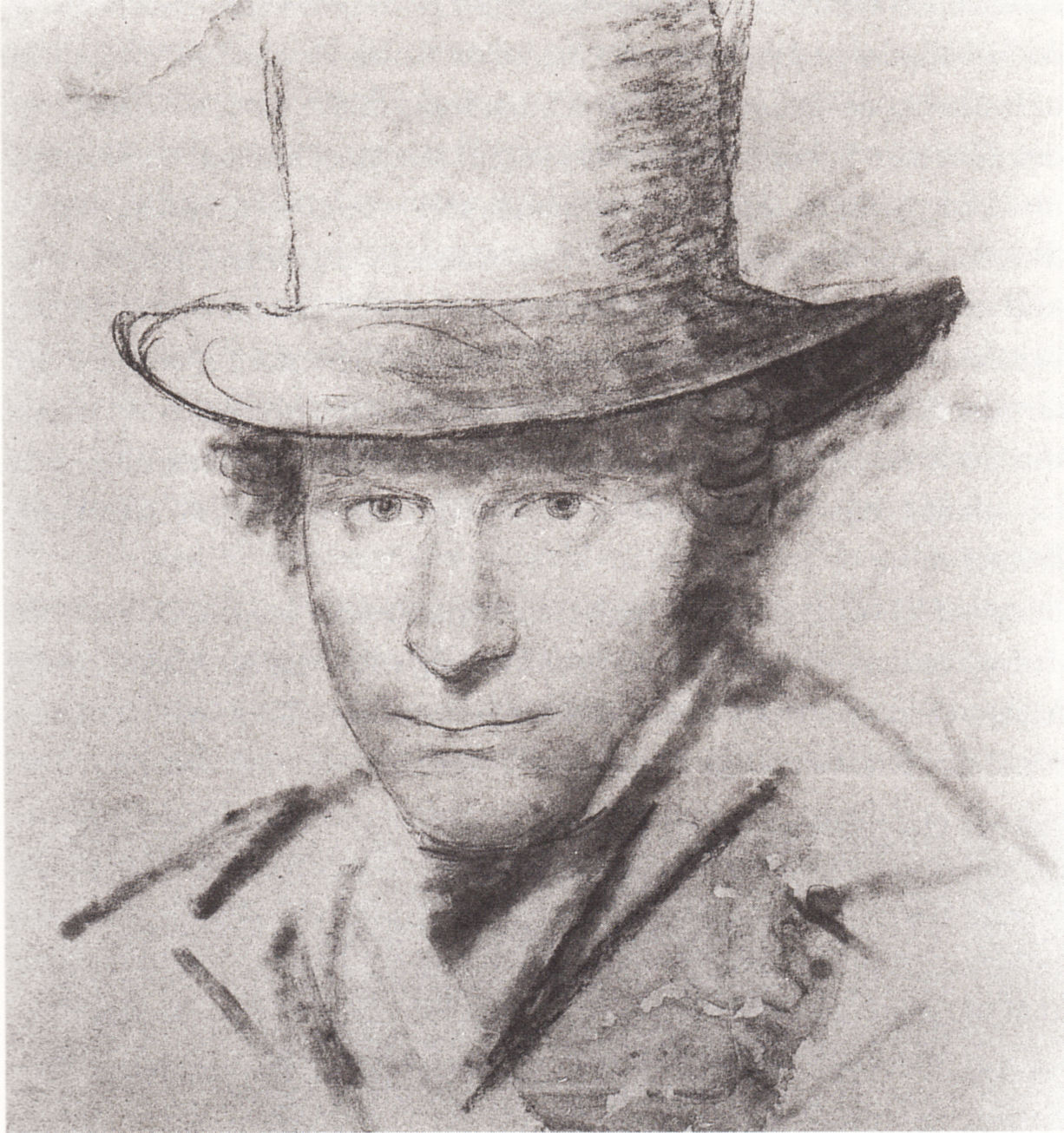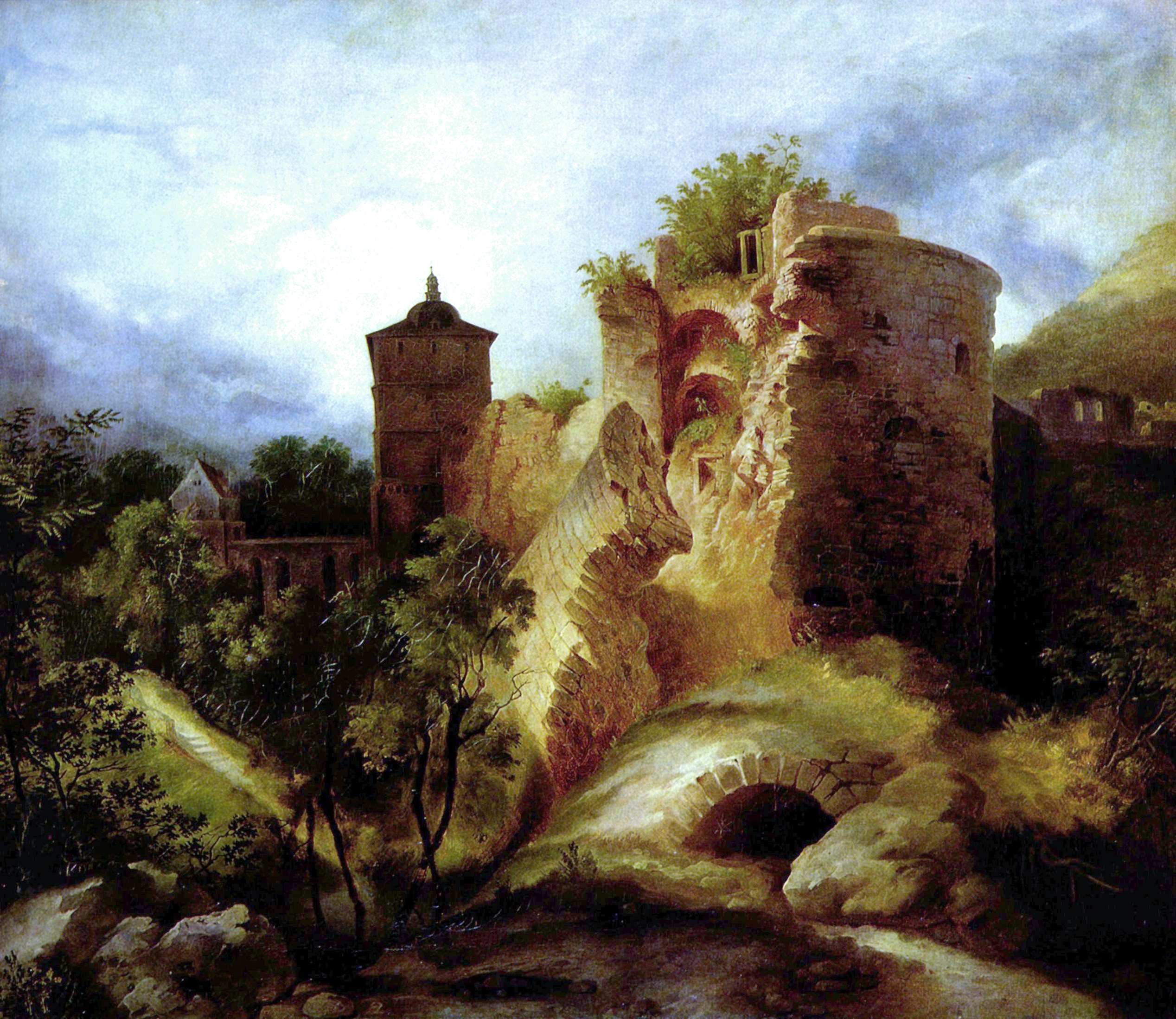Carl Blechen on:
[Wikipedia]
[Google]
[Amazon]
 Carl Eduard Ferdinand Blechen (29 July 1798,
Carl Eduard Ferdinand Blechen (29 July 1798,
 His father was a minor tax official from Regensburg. From 1805 to 1815 he attended the Lyceum at the Oberkirche St.Nikolai in Cottbus. His parents could not afford to pay for any further education, so they apprenticed him to a banker and he was engaged in that profession until 1822, when an increasing interest in art led him to the Berlin Academy.
After a short study trip to Dresden and
His father was a minor tax official from Regensburg. From 1805 to 1815 he attended the Lyceum at the Oberkirche St.Nikolai in Cottbus. His parents could not afford to pay for any further education, so they apprenticed him to a banker and he was engaged in that profession until 1822, when an increasing interest in art led him to the Berlin Academy.
After a short study trip to Dresden and
File:Carl Blechen Im Berliner Tiergarten.jpg, ''In the Berlin Tiergarten'', 1825
File:Carl Blechen - Waldweg bei Spandau - Google Art Project.jpg, ''Forest path near
Carl Blechen Gesellschaft e.V. Cottbus
Werke von Carl Blechen
@ Digitales Belvedere * * {{DEFAULTSORT:Blechen, Carl 1798 births 1840 deaths People from Cottbus People from the Margraviate of Brandenburg German male painters Romantic painters Fantasy artists German landscape painters 19th-century German painters 19th-century German male artists
 Carl Eduard Ferdinand Blechen (29 July 1798,
Carl Eduard Ferdinand Blechen (29 July 1798, Cottbus
Cottbus (; Lower Sorbian: ''Chóśebuz'' ; Polish: Chociebuż) is a university city and the second-largest city in Brandenburg, Germany. Situated around southeast of Berlin, on the River Spree, Cottbus is also a major railway junction with exte ...
– 23 July 1840, Berlin
Berlin ( , ) is the capital and List of cities in Germany by population, largest city of Germany by both area and population. Its 3.7 million inhabitants make it the European Union's List of cities in the European Union by population within ci ...
) was a German (his mother was a Sorb) landscape painter and a professor at the Academy of Arts, Berlin
The Academy of Arts (german: Akademie der Künste) is a state arts institution in Berlin, Germany. The task of the Academy is to promote art, as well as to advise and support the states of Germany.
The Academy's predecessor organization was fo ...
. His distinctive style was characteristic of the Romantic ideals of natural beauty.
Life
 His father was a minor tax official from Regensburg. From 1805 to 1815 he attended the Lyceum at the Oberkirche St.Nikolai in Cottbus. His parents could not afford to pay for any further education, so they apprenticed him to a banker and he was engaged in that profession until 1822, when an increasing interest in art led him to the Berlin Academy.
After a short study trip to Dresden and
His father was a minor tax official from Regensburg. From 1805 to 1815 he attended the Lyceum at the Oberkirche St.Nikolai in Cottbus. His parents could not afford to pay for any further education, so they apprenticed him to a banker and he was engaged in that profession until 1822, when an increasing interest in art led him to the Berlin Academy.
After a short study trip to Dresden and Saxon Switzerland
Saxon Switzerland (german: Sächsische Schweiz) is a hilly climbing area and national park around the Elbe valley south-east of Dresden in Saxony, Germany. Together with the Bohemian Switzerland in the Czech Republic it forms the Elbe Sand ...
, he returned to Berlin and obtained a position as a decorator for the Royal Theater on the Alexanderplatz. He married in 1824 and became a member of the Berlin Artists' Association in 1827. Later that year, he was dismissed from the Theater because of an ongoing dispute with singer Henriette Sontag
Henriette Sontag, born Gertrude Walpurgis Sontag, and, after her marriage, entitled Henriette, Countess Rossi (3 January 1806 – 17 June 1854), was a German operatic soprano of great international renown. She possessed a sweet-toned, lyrical voi ...
. After that, he tried to support himself as a free-lance artist. In 1828, he took a study trip to the Baltic Sea
The Baltic Sea is an arm of the Atlantic Ocean that is enclosed by Denmark, Estonia, Finland, Germany, Latvia, Lithuania, Poland, Russia, Sweden and the North and Central European Plain.
The sea stretches from 53°N to 66°N latitude and ...
, followed by a trip to Italy which produced hundreds of sketches that were later elaborated in his Berlin studio. He had been deeply impressed by the landscapes there and altered his entire manner of painting to reflect what he had seen.
Final years and illness
In 1831, upon the recommendation ofKarl Friedrich Schinkel
Karl Friedrich Schinkel (13 March 1781 – 9 October 1841) was a Prussian architect, city planner and painter who also designed furniture and stage sets. Schinkel was one of the most prominent architects of Germany and designed both neoclassic ...
, he was appointed Professor of Landscape Painting at the Berlin Academy. Despite this appointment, King Frederick William III commissioned Blechen to paint '' The Interior of the Palm House on the Pfaueninsel Near Potsdam'', an indoor scene rather than an outdoor landscape. In 1835 he became a full member of the Academy and took a study trip to Paris. It was then that the first symptoms of his mental illness appeared.
His condition deteriorated and he suffered severe bouts of depression that forced him to take a leave of absence from the Academy in 1836. The following year, he had to be admitted to a hospital. He was able to make one final trip to Dresden, where he made his last drawings. He died four years later, in a state of total mental derangement. He was buried in the Holy Trinity Cemetery (II), but the exact location is no longer known. He is commemorated with a plaque on the cemetery wall.
A street, a park and an elementary school in Cottbus were named after him. In 2008, the school building became part of the "", a major shopping center. Most of his works are in private collections. He was one of the first European painters to represent early industrialization as part of his landscapes.
Restitution cases
In 2005, the German Restitution Commission recommended that the German Federal Government restitute three paintings by Blechen to the heirs of Julius and Clara Freund, who, persecuted as Jews by the Nazi regime, fled to England in 1939. In 2008, the Blechen "''Scene of a forest with a castle, on the water front'' " was identified in aSotheby's
Sotheby's () is a British-founded American multinational corporation with headquarters in New York City. It is one of the world's largest brokers of fine and decorative art, jewellery, and collectibles. It has 80 locations in 40 countries, an ...
auction catalogue by the family of Alfred Sommerguth, a German Jewish art collector persecuted by the Nazis. Sommerguth had "fled to Cuba in 1941 at the age of 82, before reaching New York where he died a destitute in 1950". The painting was removed from the sale and returned to the heirs.
In 2012 the Blechen, “Hoehenzug mit blauen Schatten” (Mountain Range With Blue Shadows), was restituted to the heirs of Martha Liebermann, who took poison at the age of 85 to escape deportation to a Nazi concentration camp. Seized by the Nazis and intended for Adolf Hitler's planned “Fuehrermuseum, they were handed to the German government by the Allies after World War II on the understanding that they would be returned to the original owner. Instead, it was classified as "property of the Federal Republic of Germany" and kept.
In 2014 the Staatliche Kunstsammlung Karlsruhe discovered the Nazi-era history of Blechen’s ''Santa Scholastica'' and restituted the artwork to the heirs of the Jewish publisher and art collector Rudolf Mosse.
In 2016, however, the Austrian Art Restitution Advisory Board decided against restituting three works by Blechen in the Albertina
The Albertina is a museum in the Innere Stadt (First District) of Vienna, Austria. It houses one of the largest and most important print rooms in the world with approximately 65,000 drawings and approximately 1 million old master prints, as well ...
. They had belonged to Julius Freund.
Gallery
Spandau
Spandau () is the westernmost of the 12 boroughs () of Berlin, situated at the confluence of the Havel and Spree rivers and extending along the western bank of the Havel. It is the smallest borough by population, but the fourth largest by land ...
'', 1835
File:Carl Blechen - Bau der Teufelsbrücke (1833).jpg, ''Building the Teufelsbrücke'', 1830–32
File:View of Assisi by Carl Blechen (4280101317).jpg, ''View of Assisi'' 1832-35
File:Carl Blechen - Marina Grande, Capri.jpg, ''Marina Grande, Capri
Marina Grande is the main port of the island of Capri in Italy, to the north of the main town of Capri and at the foot of Mount Solaro.
History
The Marina Piccola, on the island's southern shore, preceded the Marina Grande; it was used by ...
'', 1829
File:Carl Blechen - Schlucht bei Amalfi - Google Art Project.jpg, ''Gorge'' ''near Amalfi
Amalfi (, , ) is a town and ''comune'' in the province of Salerno, in the region of Campania, Italy, on the Gulf of Salerno. It lies at the mouth of a deep ravine, at the foot of Monte Cerreto (1,315 metres, 4,314 feet), surrounded by dramati ...
'', 1831
File:Carl Blechen 007.jpg, ''In Villa d'Este
The Villa d'Este is a 16th-century villa in Tivoli, near Rome, famous for its terraced hillside Italian Renaissance garden and especially for its profusion of fountains. It is now an Italian state museum, and is listed as a UNESCO World Herita ...
Park'', 1830
File:Carl Blechen - The Interior of the Palm House on the Pfaueninsel Near Potsdam - 1996.388 - Art Institute of Chicago.jpg, '' The Interior of the Palm House on the Pfaueninsel Near Potsdam'', 1834
References
Further reading
* Trudla Malinkowa, ''Sorbische Denkmale'', Domowina, Bautzen (2021) * * Irma Emmrich, ''Carl Blechen'', Verlag der Kunst, Dresden (1989) * ''Carl Blechen. Zwischen Romantik und Realismus'', Exhibition Catalog from the Berliner Nationalgalerie, Prestel Verlag, Munich (1989) * ''Carl Blechen. Bilder aus Italien'', Bezirksmuseum Cottbus, Schloss Branitz, Cottbus (1990) * Beate Schneider, ''Carl Blechen'', Niederlausitzer Landesmuseum Cottbus, E. A. Seemann, Leipzig (1993) * Heino R. Möller, ''Carl Blechen'', from ''Romantische Malerei und Ironie'', Alfter (1995) * Barbara Baumüller,Gerd-Helge Vogel
Gerd-Helge Vogel (born 18 April 1951) is a German art historian.
Life
Vogel was born in Zwickau (Saxony) and grew up as the son of the dentist Helmut Vogel and his wife ''Lisa'', ''née'' Leupold, in Hartenstein in the Erzgebirge. From 1966 ...
(eds.), ''Carl Blechen (1798-1840). Grenzerfahrungen - Grenzüberschreitungen'', Greifswalder Romantikkonferenz, Steinbecker Verlag Rose, Greifswald (2000)
* Beate Schneider, Reinhard Wegner(eds.), ''Die neue Wirklichkeit der Bilder. Carl Blechen im Spannungsfeld der Forschung'', Lukas, Berlin (2008)
* (1981)
External links
Carl Blechen Gesellschaft e.V. Cottbus
Werke von Carl Blechen
@ Digitales Belvedere * * {{DEFAULTSORT:Blechen, Carl 1798 births 1840 deaths People from Cottbus People from the Margraviate of Brandenburg German male painters Romantic painters Fantasy artists German landscape painters 19th-century German painters 19th-century German male artists